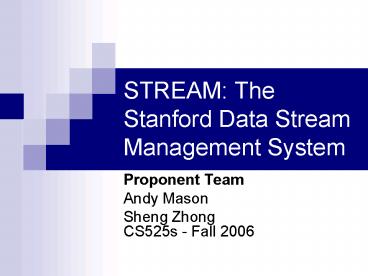STREAM: The Stanford Data Stream Management System - PowerPoint PPT Presentation
Title:
STREAM: The Stanford Data Stream Management System
Description:
No intelligent way for applications with continuous data streams to query data ... Reinvestigate data management and query processing ... – PowerPoint PPT presentation
Number of Views:142
Avg rating:3.0/5.0
Title: STREAM: The Stanford Data Stream Management System
1
STREAM The Stanford Data Stream Management System
- Proponent Team
- Andy Mason
- Sheng ZhongCS525s - Fall 2006
2
Introduction
- Motivation
- Overview
- Features
- User Interfaces
- Future work
3
Motivation
- No intelligent way for applications with
continuous data streams to query data using
regular databases - Network monitoring
- Telecommunications data management
- Sensor networks
- Reinvestigate data management and query
processing - Multiple, continuous, rapid, time-varying data
streams - Goal is to address the following
- Basic theory results
- Algorithms
- Implementing a comprehensive prototype data
stream management system
4
Overview of STREAM
- STanford stREam datA Manager (STREAM)
- Developed by Stanford in 2002/2003-2005 (Ended,
Jan 2006) - Uses traditional relational operators in a
streaming context - Basic query
- Concept SQL lttuple, timestampgt
- Relational database
- relation in, relation out (i.e.
relation-to-relation) - STREAM
- stream-to-relation
- stream-to-stream
- relation-to-relation
- Developed new query language
- Continuus Query Language (CQL)
5
Overview of STREAM (2)
- Data streams and stored relations
- Declarative language for registering continuous
queries - Flexible query plans and execution strategies
- Textual, graphical, and application interfaces
- Relational, centralized (for now)
Ref Widom, slide 8
6
The Big Picture
DSMS
Scratch Store
Stored Relations
Ref Widom, slide 6
7
Network Monitoring
Intrusion Warnings
Online Performance Metrics
Register Monitoring Queries
DSMS
Network measurements, Packet traces
Scratch Store
Lookup Tables
Ref Widom, slide 7
8
CQL Continuous Query Language
- Essentially a minor extension to SQL
- Stream-to-relation
- Sliding window over a stream
- Relation-to-stream
- 3 operators Istream, Dstream, Rstream
- Relation-to-relation
- Basically uses standard SQL
9
CQL Examples
- Windowed join of two streams S1 and S2
- Select from S1 Rows 1000,
- S2 Range 2 Minutes
- Where S1.AS2.A and S1.A gt 10
- Probe stored table R based on each tuple in
stream S and stream the result - Select Rstream(S.A, R.B) from S Now, R
- Where S.A R.A
10
Query Plans
- Each registered CQL query is compiled into a
STREAM query plan - Query plan components
- Operators perform the processing
- Queues buffer tuples
- Synopses store operator state
11
Simple Query Plan
- Select from
- S1 Rows 1000,
- S2 Range 2 Minutes
- Where
- S1.AS2.A
- And
- S1.A gt 10
Ref STREAM, Section 3.4
12
Synopsis Sharing
- Multiple synopsis within a single query plan
materializing nearly identical relations - Replace two synopses with lightweight stubs
- Use a single store to hold the actual tuples
Ref STREAM, Section 4
13
Operator Scheduling
- Global scheduler invokes run method of query plan
operators with timeslice parameter - Many possible scheduling objectives minimize
latency, memory use, computation, inaccuracy,
starvation, - Round-robin
- Minimize queue sizes
- Minimize combination of queue sizes and latency
- Parallel versions of above
Ref Widom, slide 39
14
Handling Stream Overloads
- Load-shedding discarding tuples
- Goal deliver best possible approximate answer
while not falling behind - What is definition of best?
- Maximum subset
- Maximum random sample
- We have techniques with provable guarantees for
specific query types - Extremely hard problem for general plans
Ref Widom, slide 40
15
Notes on Time in STREAM
- All stream elements have timestamps
- Necessary for time-based windows
- Necessary for consistent well-defined semantics
over multiple streams and updatable relations - Basic correctness requirement query processor
must see stream elements in timestamp order - Easy when time is centralized system clock
- Stream elements timestamped on entry to system
Ref Widom, slide 43
16
Application-Defined Time
- Streams may contain application timestamps
- Sensor readings, financial transactions, etc.
- Elements may arrive out of order at DSMS
- Distributed streams with time skew among them
- Latency reaching DSMS
- Reordering on transmission channel
- Our solution heartbeats
- Provided by application or deduced from measured
parameters (skew, latency, etc.)
Ref Widom, slide 44
17
STREAM User Interfaces
- Main interface (initial)
- Web
- Register queries
- STREAM visualizer
- Windows-based application
- View query plans
- View detailed system information (memory, cpu)
- Dynamically adjust properties
- View monitoring graphs
- Platform independent usage (planned)
- SOAP (HTTP/XML) interface
- Register queries
- Stream results over network
18
Future Work
- Distributed Stream Processing
- Crash Recovery
- Improved Approximation
- Relationship to Publish-Subscribe Systems
19
Summary
- Motivation behind STREAM
- STREAM Stanfords solution
- Core features
- Future Work
20
References
- Widom, Jennifer The Stanford Data Stream
Management System - http//www-db.stanford.edu/widom/stream-talk.ppt
- STREAM The Stanford Data Stream Management
System - http//web.cs.wpi.edu/cs525/f06s-EAR/cs525-homepa
ge_files/LITERATURE/STREAM-overview-book-chapter-2
004-20.pdf































